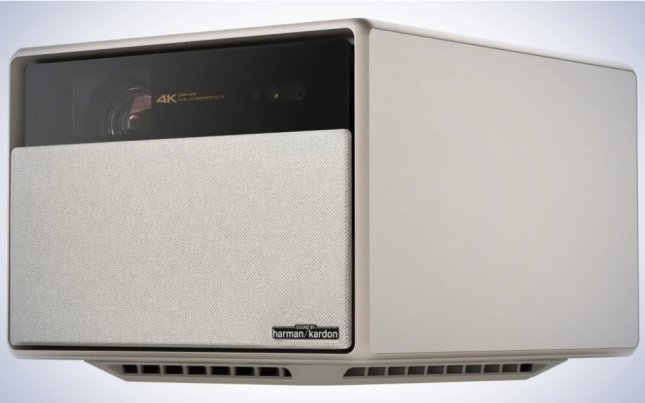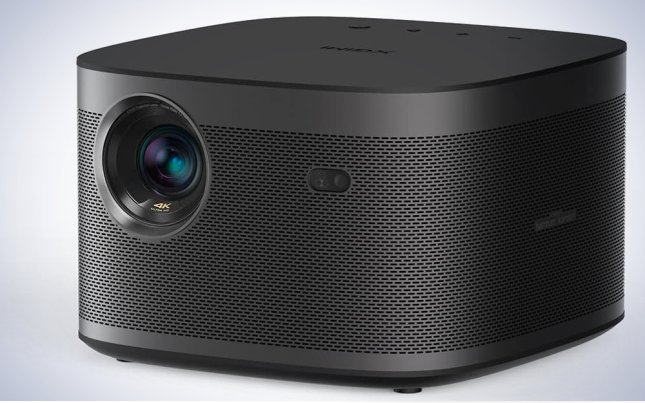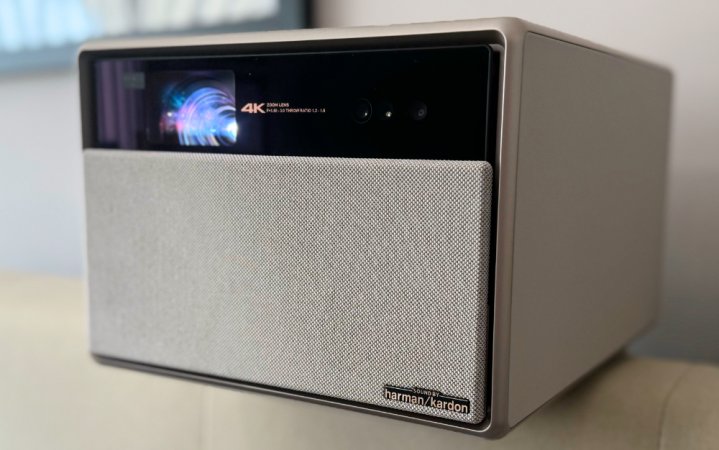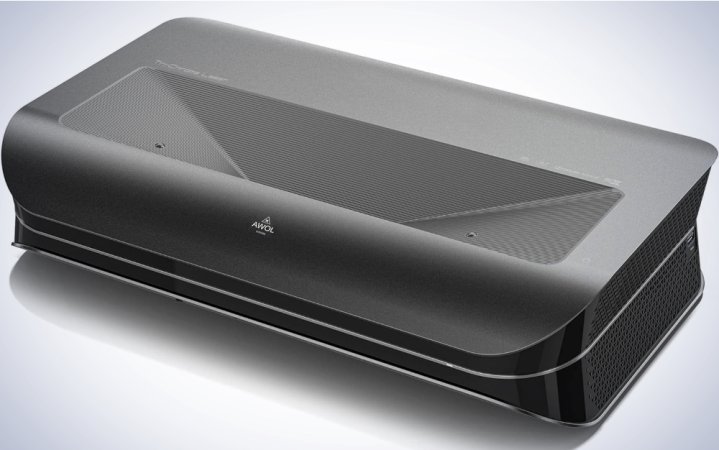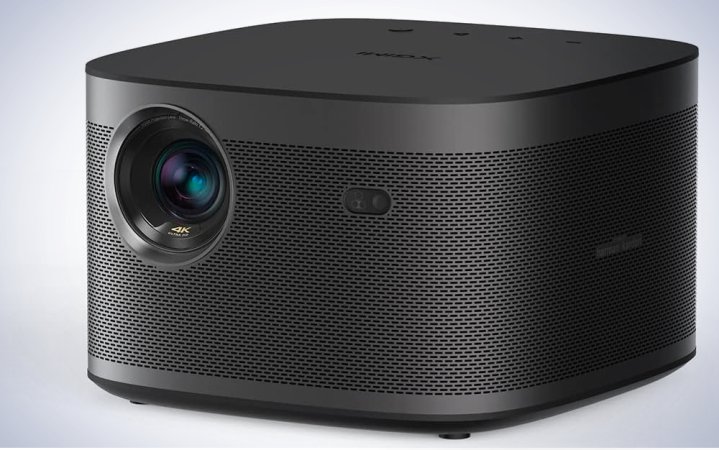We may earn revenue from the products available on this page and participate in affiliate programs. Learn more ›
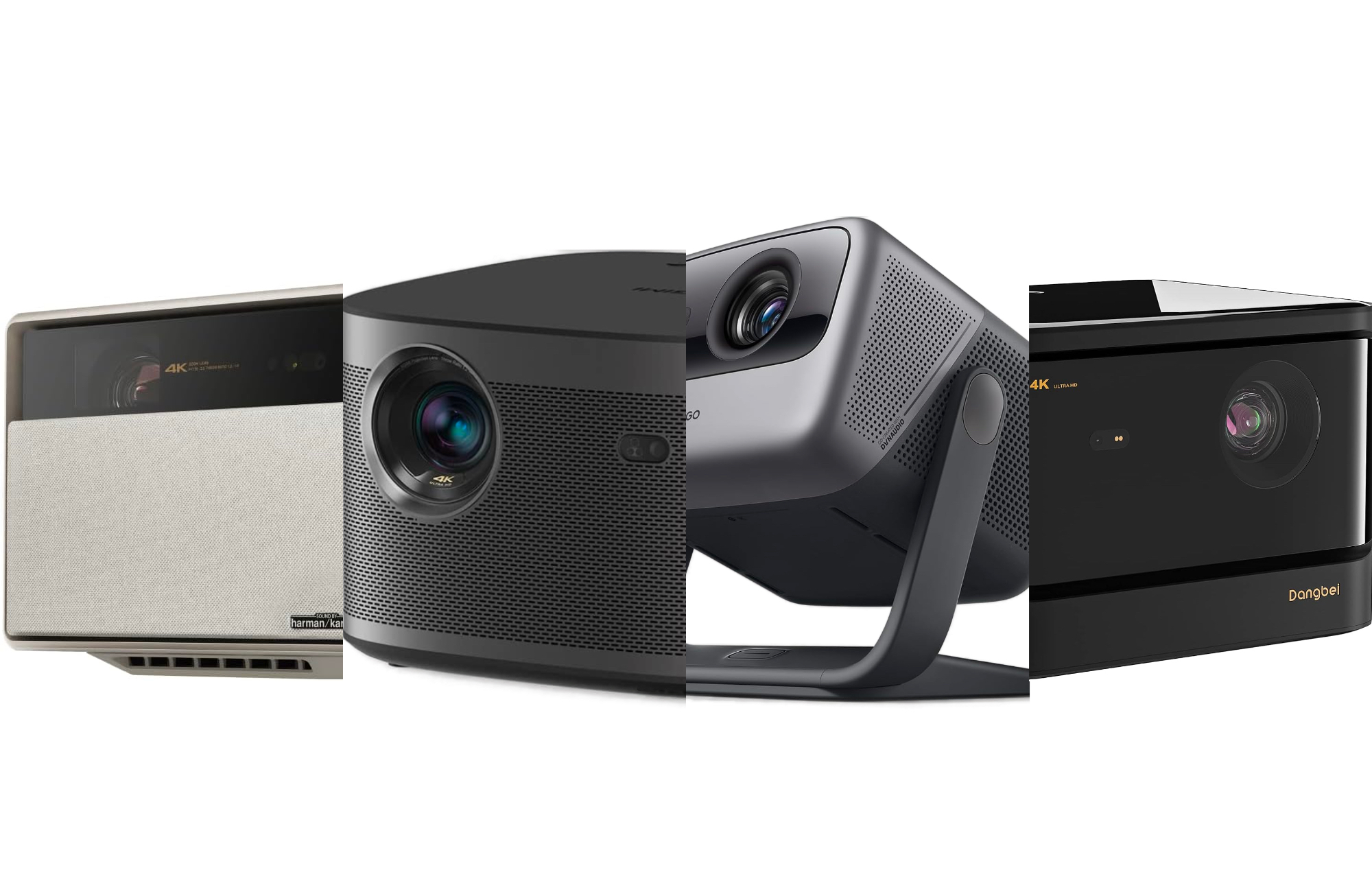
A 4K projector is the ultimate tool for cinephiles or gamers who want to get the most out of their ultra-high definition films and games without getting into multi-thousand-dollar screens and burdensome furniture. Only the most expensive TVs can even come close to the literal scale of a projector’s maximum screen size, and then you deal with the challenges of anchoring a 110-inch flatscreen. Moreover, 4K projection technology has evolved enough to fall significantly in price over the past couple of years. Spending a lot for the absolute premium models is still possible, but most of our recommendations will set you back under $2,000. A 65-, 75-, or even 85-inch 4K TV could still be the most cost-effective choice, but there’s no denying that 4K projectors have become much more accessible. The best 4K projectors will allow you to achieve the dream of bringing a movie theater into your house with no compromises.
- Best overall: XGIMI Horizon Ultra
- Best splurge: AWOL Vision LTV-2500
- Best design: JMGO N1 Ultra
- Best for bright rooms: Dangbei Mars Pro
- Best budget: XGIMI Horizon Pro
How we chose the best 4K projectors
There are more 4K projectors than ever, and our recommendations come from extensive research and hands-on testing. We watched movies and played games on these devices to see how they held up during fast-paced action and casual viewing alike. Our tests were conducted by projecting images onto a wall from approximately nine feet away. Games were played on a Nintendo Switch, while videos were watched using both the projector’s internal operating system (if applicable) and Roku Streaming Stick 4K.
The best 4K projectors: Reviews & Recommendations
Whether you’re upgrading from a TV or Full HD projector, our 4K projectors for movies will be a significant upgrade and a massive step toward creating the ideal home theater system.
Best overall: XGIMI Horizon Ultra
XGIMI Horizon Ultra
Pros
- Stunning video quality
- Harman Kardon audio system
- Snappy user interface
Cons
- No native Netflix
Specs
- Lumens: 2,300
- Ports: 2 x HDMI, 2 x USB-A, 1 x Ethernet, 1 x Optical, 1 x AUX
- Speakers: Yes
- Price $1,599
XGIMI’s Horizon Ultra is hands-down the best 4K projector we’ve tested yet, from its thoughtful design (even its remote is premium, encased in metal, not plastic) to its video fidelity. The projector is rectangular, a “Misty Gold” cube with “eco leather” on the top and sides and fabric covering most of its front. When the projector is off, the covering you see above is up, protecting the projector’s lens from getting scratched or accumulating dust. When the projector is turned on, the front covering glides downward, revealing the lens. It’s a neat trick that never got old during months of testing. XGIMI gets top marks by making a 4K projector with both a functional and whimsical design.
Where audio and video quality are concerned, XGIMI also gets top marks. The Horizon Ultra continually produced a bright, colorful image even in a room with some light leakage. If the curtains aren’t drawn, well, the Horizon Pro can’t compete with direct sunlight—but few projectors can. However, if you set this 4K projector up in a dark environment—even a room where the sun peeks through the blinds during the day—you’ll be constantly impressed by what this projector’s LED + laser lamps and their 2,300 ISO lumens deliver. It’s the first long-throw 4K projector with Dolby Vision (plus HDR10 and HLG), and that heightened contrast and dynamic color adjustment are apparent as you watch throughout the day and night. Plus, optical zoom plus automatic keystone correction and focus allow for an image size of 40 to 200 inches and flexible positioning, up to 40 degrees off-center.
Playing video games like Phantasy Star Second Story R, wherein characters dart across the screen while visual effects pop up constantly, was no problem for the Horizon Pro’s 18ms latency and 60Hz refresh rate, which handled the task with aplomb. Watching soccer games or Netflix shows like Chef’s Table (more on that shortly) was similarly satisfying. This 4K projector’s color reproduction was fantastic and shows or games with support for HDR (high dynamic range) look even better. Similarly, the projector’s built-in 2x12W stereo sound system, courtesy of Harman Kardon, was equally impressive. It didn’t stack up compared to a wireless surround sound setup, but it did its job, capable of decoding Dolby and DTS and delivering clear dialogue and deep bass. We never felt the need to connect external speakers to the projector, which was quite the feat.
The XGIMI Horizon Ultra runs on Google TV. While the Android 11 operating system connected through Wi-Fi 6 moved fluidly—we could get in and out of apps and settings easily—the lack of native Netflix on the platform was bothersome. This wasn’t an issue since our testing included hooking up a media streamer (and there are workarounds if you’re willing to side-load apps), but could prove annoying for some. With that blemish aside, we can wholeheartedly recommend XGIMI’s Horizon Ultra to anyone interested in getting a 4K movie projector right now. (And if you have a really big wall and are willing to wait, XGIMI’s upcoming Horizon Max, announced at CES 2024, offers an IMAX 1.90:1 aspect ratio, more lumens, an updated Intelligent Screen Adaption system, and more immersive sound … for a higher price).
Best splurge: AWOL Vision LTV-2500
AWOL Vision LTV-2500
Pros
- Very high luminosity
- Ultra short throw
- 3D film support
Cons
- Price
Specs
- Lumens: 2,600
- Ports: 2 x HDMI, 1 x Ethernet, 1 x AV-in, 1 x Optical
- Speakers: Yes
- Price: $2,998
AWOL Vision’s LTV-2500 is an incredible indulgence for the most persnickety media viewer—especially those without a lot of space. This is a short-throw triple-laser projector, which means it can create a 100-plus-inch screen while being only a foot or so away from your wall. The projector itself is significantly larger than any of our other recommendations, but the fact that you don’t need to keep it several feet away from your wall means it can fit neatly on top of any entertainment center. If you’re swapping out a TV for a 4K laser projector, the LTV-2500 will provide the smoothest transition, which is especially helpful if you’ve already set up an AV receiver with a surround sound system. If you don’t have speakers set up, you’ll appreciate that the LTV’s audio system can play back Dolby Atmos surround sound audio natively.
The LTV-2500 supports all the most popular video technologies, from HDR 10+ to Dolby Vision, with 2,600 lumens plus support for over 1 billion colors and 147 percent of DCI-P3, and it also actively supports 3D video. If you have a pair of active shutter 3D glasses, a Blu-ray player that supports 3D movies, and a cache of 3D films, you can enjoy them in their full fidelity. This is surprising considering how badly 3D movies sold, but it’s a welcome feature if you’d like to play your entire movie library in the highest possible quality with every feature intact.
This projector doesn’t run an operating system, but AWOL Vision includes an Amazon Fire Stick 4K Max, which you can use to stream content from any popular streaming service. It’s a pain to burn one of its two HDMI ports on a media streamer, especially given the LTV-2500’s high price, but this won’t be an issue if you connect a game console or other multifunctional device with access to Netflix, YouTube, and other services. If you’d like to set up a home theater system with a 4K projector but don’t have a lot of room, AWOL Vision’s LTV-2500 is the best choice.
Best design: JMGO N1 Ultra
Pros
- “Freestyle” flexible design
- Great video quality
- Solid image correction
Cons
- No Netflix
Specs
- Lumens: 2,200
- Ports: 2 x HDMI, 1 x USB-A, 1 x headphone jack
- Speakers: Yes
- Price: $2,299
We’re wary of any gadget that seems to be predicated on a gimmick, but JMGO’s N1 Ultra isn’t a one-trick pony. Its standout feature is that the triple-laser projector is suspended on top of its stand, allowing you to tilt it upward and downward up to 135 degrees easily. And its gimbal allows for a 360-degree horizontal pan. This comes in handy if you’re trying to position it just so or want to project your video onto a ceiling for a limited time. In our experience, the N1 Ultra’s flexibility was a huge asset. Moving it was simple, but the 4K projector never tilted on its own; JMGO managed to tweak its torque to avoid accidents.
We tested the N1 Ultra and its 2,200 CVIA lumens/HDR10 support/1600:1 contrast ratio during extended play sessions of The Legend of Zelda: Tears of the Kingdom, and it allowed us to take in the verdant green hills, snowy peaks, and harsh deserts of Hyrule in their full fidelity. The projector was bright enough to compete with light leaking through curtains in our testing space, with no big picture quality loss, thanks in part to Auto Adaptive Brightness, Auto Keystone Correction, Smart Object Avoidance, Auto Screen Fitting, and more smart features. Video from streaming services also looked sharp, though the lack of Netflix on Google TV proved troublesome once again. 4K videos from professional YouTubers were a treat for the eyes, however. Where sound is concerned, the 10Wx2 speaker system was solid, though it couldn’t quite match the fidelity of the speakers built into XGIMI’s Horizon Ultra.
Still, if you’d like a 4K projector that’s easy to tweak and whose eye-catching design isn’t just for show, JMGO’s N1 Ultra is more than worth a look.
Best for bright rooms: Dangbei Mars Pro 4K
Dangbei Mars Pro 4K
Pros
- Ultra bright
- Packed with ports
- Excellent audio quality
Cons
- No operating system
Specs
- Lumens: 3,200
- Ports: 2 x HDMI, 2 x USB-A, 1 X Ethernet, 1 X optical audio, 1 x headphone jack
- Speakers: Yes
- Price: $1,599
Dangbei’s Mars Pro 4K is well worth the investment for those in bright rooms and who desire booming sound. The ALPD projector’s literal bright spot is its 3,200 ANSI lumen bulb, which allowed the Mars Pro 4K to create a clear picture in a room with moderate light pollution. It’s still not suitable in a room with many windows at noon, but you don’t have to wait until night to turn it on. If you plan to set your home theater up in a living room rather than a basement and you get this projector, you’ll be fine. The Mars Pro has no built-in software, but Dengbe bundles it with an Android streaming dongle; you can also connect your media streamer of choice.
The Mars Pro supports HDR10/HLG high dynamic range formats, and our experience watching HD and ultra-high-definition content was fantastic. Colors popped, and a great amount of detail was present even in HD footage and games. We projected a screen roughly 100 inches wide (you can go up to 200), but the projector’s autofocus kept the entire frame looking sharp. Similarly, the Mars Pro 4K’s 10Wx2 audio system delivered a nice punch—though a little treble-heavy—when watching videos or playing games with the volume cranked up. That said, you won’t need to connect this projector to a speaker system if you don’t want to.
If you’re queasy about setting up a 4K projector because the room it’ll be in gets natural light for part of the day, the ultra-bright Dangbei Mars Pro 4K is the one to get.
Best budget: XGIMI Horizon Pro
Pros
- Good color reproduction
- Solid speakers
- Price
Cons
- Not quite as performant
Specs
- Lumens: 1,500
- Ports: 2 x HDMI, 2 x USB-A, 1 x Ethernet, 1 x AUX, 1 x Optical
- Speakers: Yes
- Price: $1,199
XGIMI’s Horizon Pro is a step down in performance from our best overall pick, but it’s still a solid choice if you need a 4K projector on a slightly lower budget. It has an eight-watt dual speaker audio system courtesy of Harman Kardon, is packed with every necessary port, and runs on Google TV. While it matches its more expensive technical sibling in luminosity, its speaker system is weaker, and it uses previous-generation video hardware so that color reproduction won’t be quite as good. You’ll still get a great-looking clear picture, but projectors have progressed since the Horizon Pro’s launch. Still, it has all of the essential features you’d need from a 4K projector, from support for HDR, AI brightness adjustment, and a competent auto-focus system. If you’re looking for a home theater upgrade that won’t break the bank, you’ll find it here.
FAQs
Yes. Most 4K projectors have a luminosity of between 1,500 and 2,500, so 3,000 lumens would be just fine.
A 4K projector itself can last a decade or more, but its bulb may burn out before then and need to be replaced. Many projector bulbs are designed to last about 10,000 hours (that’s 27.38 years if you use the device for an hour per day). If you plan on keeping your 4K projector for the long haul, it may be worthwhile to consider getting a replacement bulb, too.
There’s no such thing as an OLED projector. The difference between an OLED TV and a laser projector is that the former will have more consistent contrast and black levels in an optimized environment, while the latter will offer a larger screen size. There’s no wrong answer here, pick the device that works best for you.
For the optimal experience, install your 4K projector 10 feet away from the wall you’re projecting onto.
A projection screen is an added expense, but you’ll surely appreciate projecting an image onto a pristine white surface with no dips or scratches. That said, installing a projection screen may not be practical, especially if you’re renting your place, which is why a projector such as the XGIMI Horizon Ultra has automatic color correction.
This depends on its luminosity and other hardware specifications. Our 4K projector recommendations cost between $1,099 and $2,998.
What to consider when shopping for the best 4K projector for you
There are many factors to consider when deciding which 4K projector is right for you. Here are the factors we considered most important when writing this guide:
Luminosity
The brightness of a projector’s bulb is measured in lumens; the higher its luminosity, the brighter its picture—though there are different scales (ANSI vs. ISO), so keep an eye on the spec specifics. Luminosity is important because it allows your projector to overcome light pollution from the sun, lamps, or fluorescent sources. Light pollution washes out a projector’s ability to project a picture, making it look washed out or harder to see. A brighter picture is also easier to see regardless of how much external light is in the room, so you need to gauge your environment, especially if you need a projector for daylight viewing. If you have a dark(er) space, a projector’s luminosity is outranked in importance by its resolution, but all models here are 4K, offering 3840 pixels across and 2160 up and down.
Throw distance
A projector’s throw distance determines the picture size based on how far it is from a wall. “Short-throw” style projectors can be very close to a wall while still making a large picture, making them ideal for smaller spaces. Meanwhile, a typical long-throw projector works best when installed between eight and 10 feet away from your wall. Be mindful that wall space is key regardless of what type of 4K projector you get. You won’t get as much out of your projector if you don’t have enough room. This tool can help you evaluate your throw distance-to-screen size ratio.
Maximum screen size
Every 4K projector we recommend can project a picture over 100 inches long, with most capable of reaching 200. Maximum size will ultimately be determined by its throw distance and how much wall space you can provide. Because these projectors have such a high resolution, you shouldn’t deal with any significant loss in picture quality, even on an ultra-large screen.
Port selection
A 4K projector’s ports (sometimes known as inputs) will determine the types of components (e.g., game console, Blu-Ray player, streaming device) you can connect to it. Our 4K projector recommendations have at least one HDMI port—most have two—which means you can plug just about any audio or video gadget into it. Many of our recommendations also have a headphone jack or other audio out port, which allows you to connect them to external speakers for better sound.
Speakers
All 4K projectors in this guide have built-in speakers, which is helpful if you prioritize portability. Many of the speaker systems on these higher-end projectors are surprisingly robust, so you won’t need to plug in an external set to get good sound. If you want the full home theater experience, you’ll still need an AV receiver and surround sound speaker set.
Smart features
One of the standard features of premium 4K projectors is the ability to stream movies and TV shows from the most popular services directly from the device itself. Hardware makers have partnered with Google to allow their projectors to run on Google TV, a software platform that competes with FireOS and Roku.
Final thoughts on the best 4K projectors
- Best overall: XGIMI Horizon Ultra
- Best splurge: AWOL Vision LTV-2500
- Best design: JMGO N1 Ultra
- Best for bright rooms: Dangbei Mars Pro
- Best budget: XGIMI Horizon Pro
A 4K projector is still a luxury, but one that’s become significantly more attainable recently. We’re comfortable recommending them to anyone serious about setting up a home theater room in their home, even if one doesn’t set up a surround sound system right away. Setting up a 4K projector now means not having to think about a home theater upgrade for years since improvements to bulb brightness and color fidelity aren’t improving by leaps and bounds annually. If you’re looking for an entire home theater in a single box, a 4K projector is the best option.
